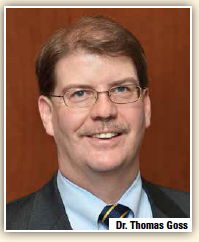Understanding of Therapeutic Value of Cancer Drugs Increases after Initial Approval
Trending now: Ongoing research and real-world application post-approval often reveal greater benefit of cancer therapies.
 The full therapeutic value of a cancer therapy is typically realized long after the drug’s initial FDA approval, according to a report from Boston Healthcare. In the report, several industry examples demonstrate why FDA approval should be viewed as a starting point for additional research into a drug’s full therapeutic potential.
The full therapeutic value of a cancer therapy is typically realized long after the drug’s initial FDA approval, according to a report from Boston Healthcare. In the report, several industry examples demonstrate why FDA approval should be viewed as a starting point for additional research into a drug’s full therapeutic potential.
Progress in cancer survival rates and improved health outcomes are not typically driven by dramatic, single breakthroughs in science and medicine, but more commonly result from an accumulation of knowledge over time. The potential to derive greater benefit from cancer therapies increases as researchers and clinicians explore all aspects of how the medicine is used, how it affects patients, and as it is evaluated in new areas.
“This research shows our understanding of how the benefits and risks of cancer therapies evolve over time as additional evidence accumulates," says Thomas Goss, Pharm.D., senior VP of Boston Healthcare and co-author of the report. “The clinical value observed at the time of initial FDA approval is generally only a partial reflection of the evidence of clinical efficacy and safety that a new therapy provides to patients.
Ongoing research and real-world clinical practice reveal important information about how to best use new therapies. This building process is central to the long-term realization of significant clinical gains for treating cancer and many other diseases."
A New Record to be Set for M&A
A survey of biopharmaceutical dealmakers by Campbell Alliance suggests that 2015 will set a new record for mergers and acquisitions and licensing of biopharmaceutical assets.
“The level of dealmaking activity last year was the highest it has been since 2009 and activity in 2015 is set to surpass it," says  Neel Patel, VP, Campbell Alliance. “But this time, M&A activity is being fueled by small and mid-cap biopharma buyers, who are flush with cash. And the details of what we found across the sector should be of interest to anyone evaluating buying or selling an asset in 2015."
Neel Patel, VP, Campbell Alliance. “But this time, M&A activity is being fueled by small and mid-cap biopharma buyers, who are flush with cash. And the details of what we found across the sector should be of interest to anyone evaluating buying or selling an asset in 2015."
Mr. Patel says buyers find themselves in a highly competitive environment while sellers benefit from well-capitalized buyers and more options than in the past.
Other findings include:
A seller’s market exists for Phase III CNS, preclinical, and Phase III oncology, and Phase III women’s health assets.
A buyer’s market exists for preclinical respiratory, women’s health, and ophthalmology assets.
Hot areas/technologies of interest are largely linked with oncology as buyer demand within the therapeutic area remains high.
High-interest, oncology-related technology includes cancer vaccines, antibody drug conjugates, personalized medicine and
immuno-oncology.
Innovation has gravitated toward oncology where pricing and access risk is relatively low. Trial costs and length similarly are low versus other therapeutic areas.
Large Pharma Turn to Speciality Groups for Expertise
 Sponsor companies may outsource to several different types of contract research organizations (CROs) for a single clinical trial. A traditional full-service CRO can provide sponsors with all clinical trial services, ranging from protocol development to site negotiations and regulatory filings. But sponsors may also turn to specialty CROs for expertise in a narrow aspect of trial management, such as patient recruitment or site management.
Sponsor companies may outsource to several different types of contract research organizations (CROs) for a single clinical trial. A traditional full-service CRO can provide sponsors with all clinical trial services, ranging from protocol development to site negotiations and regulatory filings. But sponsors may also turn to specialty CROs for expertise in a narrow aspect of trial management, such as patient recruitment or site management.
According to Cutting Edge Information, 75% of teams at Top 10 and Top 50 companies contract with patient recruitment organizations. Another 25% employ site management organizations (SMOs). Sponsors may turn to one of these specialty CROs to conduct a particular part of the clinical trial while maintaining core operations in-house.
“Smaller companies may not have the resources to design and manage all clinical trial activities, so they may lean heavily on full-service CROs," says Sarah Ray, senior analyst at Cutting Edge Information.
Pharma Pipeline Value Increases
Emerging therapeutic categories and a string of breakthrough drug approvals are powering key drug sales across the United States and Europe, fueling a projected 5% increase in global prescription sales over the next five years, according to the EvaluatePharma.
“Any fears that the pharmaceutical industry might be heading toward a slowdown after the last two years of phenomenal growth can be put to rest for now," says Lisa Urquhart, editor of EP Vantage, the editorial arm of Evaluate. “However, for the industry to sustain this impressive growth they will have to make compromises around global pricing and market access. As such, pharmaceutical companies need to either accept lower prices for its products, or persuade payers that the therapeutic benefits outweigh the cost of disease."
Other highlights:
Worldwide prescription drug sales to reach nearly $1 trillion by 2020 with a CAGR of 4.8% between 2014 and 2020.
2014 U.S. prescription drug sales surge 8.9%; Europe returns to growth with a 2.4% jump while Japanese sales in yen dropped by 2.6%.
R&D pipeline values increase to $492.8 billion from $418.5 billion in 2014.
Value of M&A transactions almost doubled to $116 billion in 2014; value of venture financing deals leapt 36% to $8.2 billion. (PV)
~~~~~~~~~~~~~~~~~~~~~~~~~
Therapeutic trax
Biologics
The global biosimilars market is expected to reach $20 billion by the end of 2015 and could hit $55 billion by 2020, with growth primarily being driven by a promising pipeline in active development and government efforts to reduce healthcare spending. Biologics currently account for between 17% and 20% of the pharma arena, with a value of almost $200 billion, and these products may replace 70% of chemical drugs in the next two decades.
Source: GBI Research
Cancer
The breast cancer market is expected to increase from its estimated value of $9.2 billion in 2013 to more than $13.1 billion by 2020, representing a CAGR of 5.1%. Despite the launch of trastuzumab biosimilars that are likely to compete actively with
Herceptin, branded drugs will become more favored by 2020. This, along with a gradual increase in the use of targeted therapies, will help to drive the almost $4 billion growth in the overall breast cancer treatment market value over the forecast period.
Source: GBI Research
The value of the global glioblastoma multiforme treatment market will expand at a rapid CAGR of 10.9%, from $301 million in 2013 to $623 million by 2020. This growth will be driven by the approval of novel products with high tumor specificity that significantly improves patient survival. These include the DCVax-L vaccine, anticipated to launch in Europe in 2016.
Source: GBI Research
The non-Hodgkin lymphoma (NHL) treatment market will expand at a CAGR of 7.4%, from $5.6 billion in 2013 to more than $9 billion by 2020. The United States will have the largest part of the market, valued at $5.2 billion, due to increasing disease incidence and uptake of targeted and immunotherapies. With 339 pipeline molecules, most of the investigational drug candidates are being evaluated for first- or second-line treatment, including novel mAbs, antibody-drug conjugates, radioimmunotherapies, small-molecule inhibitors, and new chemotherapies.
Source: GBI Research
The global non-small cell lung cancer (NSCLC) treatment market value will increase from $5.1 billion in 2013 to slightly more than $7.9 billion by 2020, expanding at a CAGR of 6.6%. This growth will be driven primarily by the introduction of numerous premium therapies, particularly in second-line and squamous cell treatment settings, which either replace or combine with generic chemotherapies.
Source: GBI Research
While the treatment pipeline for pancreatic cancer shows a high level of innovation, with 52% of products categorized as first-in-class, most development is in the early stages, meaning a significant proportion of therapies are unlikely to reach the market in the near future. While the pancreatic cancer treatment pipeline contains 447 therapeutics in active development across all phases, compared with 209 currently marketed products, almost 75% of therapies are in Phase I development or earlier.
Source: GBI Research
Sales of melanoma-related therapies are projected to rise in the eight major markets at a CAGR of 15.5%. In particular, the EU melanoma market is expected to grow the most rapidly, increasing by 2023, at a robust CAGR of 18.3%.
Source: GlobalData
The cancer vaccine market is growing at a CAGR of 27% to 2019. The use of vaccines in combination with other therapies is propelling the growth of cancer vaccines market across the world in addition to frequent occurrence of different types of cancer and the introduction of various cancer vaccines.
Source: Infiniti Research
CNS
The Parkinson’s disease treatment market value across the eight major countries of the U.S., France, Germany, Italy, Spain, the UK, Japan, and Brazil will reach $4.7 billion by 2022, driven primarily by an aging population and increasing disease prevalence. Most late-stage pipeline agents are set to meet the needs of advanced Parkinson’s disease patients, with three drugs expected to launch by 2022, namely CVT-301, opicapone, and tozadenant.
Source: GlobalData
Diabetes
The global insulin market is expected to reach $47.54 billion by 2020. Growing global prevalence of type 1 and type 2 diabetes and the presence of high unmet needs in emerging markets such as India and China are expected to be two significant growth drivers of this market. Moreover, increasing incidence rates of lifestyle-induced diseases such as obesity and growing global geriatric population base are expected to serve the global insulin market as drivers.
Source: Grand View Research
Respiratory
The diverse treatment pipeline for asthma has many first-in-class products representing significant investment opportunities. While asthma therapy development is dominated by small-molecule compounds, with 156 products representing 67% of the pipeline, the R&D landscape has moved towards biologics on an unprecedented scale. There are now 60 biologics in the pipeline, representing a 26% share.
Source: GBI Research










